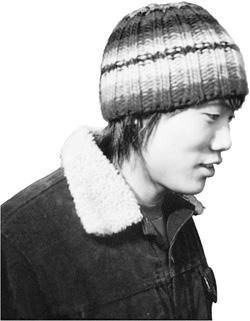Stitch 'n Bitch: The Knitter's Handbook (35 page)
Read Stitch 'n Bitch: The Knitter's Handbook Online
Authors: Debbie Stoller

US 9 (5.5mm) knitting needles, or size needed to obtain gauge
G
AUGE
30 sts and 20 rows = 4" in k1, p1 rib
S
TITCH
P
ATTERN
K1, P1 RIB (OVER EVEN NUMBER OF STS)
All rows: *K1, p1; rep from * across.
D
IRECTIONS
With A, CO 30 sts. Work 45 rows in k1, p1 rib.
Divide in half for opening: Rib 15 sts, attach second skein of A, and rib rem 15 sts. Rib 10 rows, knitting both sides at the same time.
Rejoin two sides by working across the next row with one skein only. Cont until 100 rows total have been worked with A.
Change to B and cont in rib for 100 rows. BO. Work away ends.
That’s it!

ABOUT JENNIFER

I am an independent graphic and Web designer from Chicago. I learned how to knit when I was seventeen from my great-aunt Bea, and I knit all through college. Whenever I knit for my boyfriends I always seemed to break up with the guy before the project would be finished—and inevitably a sweater with sleeves would quickly become a vest. I stopped for a while because of the bad mojo associated with knitting for boyfriends, but when my nephew was born, I started to knit again, and I joined the Chicago Stitch ’n Bitch. Coincidentally, my mom has been a member of a Stitch ’n Bitch (no affiliation) for thirty years now!
Knitting is a destressor for me, so I don’t pick projects with lots of counting or fancy stitches. That’s why this nondemanding scarf is perfect for anyone to try.
SHETHA NOLKE
Illusion knitting was brought to my attention through an online knitting community. Most illusion patterns, however—typically hidden hearts or secret x’s and o’s—were a bit too cutesy for knitters out there today. Once I figured out how it worked, I realized that any knitter who knows the technique can create his or her own illusion design. As proof of this, I created the alien illusion motif. Now you see him, now you don’t!
The illusion is the result of two things: knitting texture and positive/negative space images. The texture is created by combining knit (flat) with purl (raised) stitches. In order to create the texture, it’s necessary to knit at a fairly tight gauge, but not so tight as to affect the drape of the fabric. Illusion motifs are done with two colors: the positive image color (green in this case) and the negative image, or background, color (black in this case). The image is then created in “slices,” and each slice consists of four rows: two knit in the negative color and two in the positive color. Within these rows, the stitches that make up the image (a green alien head on a black background), are made with purl stitches. When the scarf is viewed from an angle, only the raised purl stitches are seen, and the image emerges. Spooky!
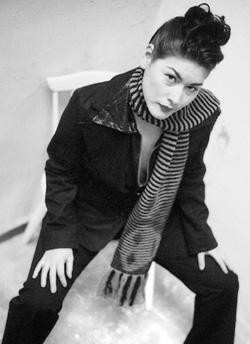
SKILLS | PAGE |
CAST ON | |
KNIT | |
PURL | |
CHANGE COLOR | |
READ CHART | |
BIND OFF |
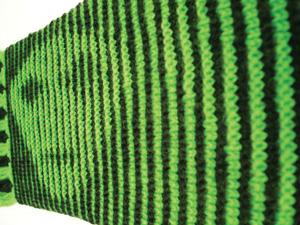
S
IZE
Approx 7" × 86", including fringe
M
ATERIALS
Brown Sheep Company
Nature Spun Worsted
(100% wool; 100g/245 yds)
MC:
1 skein #601 Pepper
CC:
1 skein #109 Spring Green
US 7 (4.5mm) knitting needles, or size needed to obtain gauge
Crochet hook for attaching fringe
G
AUGE
22 sts and 30 rows = 4" in stockinette st
Note:
Because there are only two rows worked in each color, the colors can be carried up the side of the scarf. It’s important not to pull these stitches too tightly or that edge of the scarf may be shorter than the opposite edge.
D
IRECTIONS
With MC, CO 40 sts. Foll chart beg with row 1 (RS). Rep rows 1–80 five times more for a total of 6 alien motifs. BO loosely in CC.
FINISHING
Cut 33 strands of yarn in each color approx 16" in length. To create fringes, gather 3 strands of yarn, fold
in half, and pull loop end through the CO row using a crochet hook. Thread the cut ends through the loop end and pull tightly. Rep across CO edge in alternating colors. Rep with BO edge.
The print edition of this book includes a chart for
Alien Illusion Scarf
.
Please download a PDF of this chart here:
workman.com/ebookdownloads
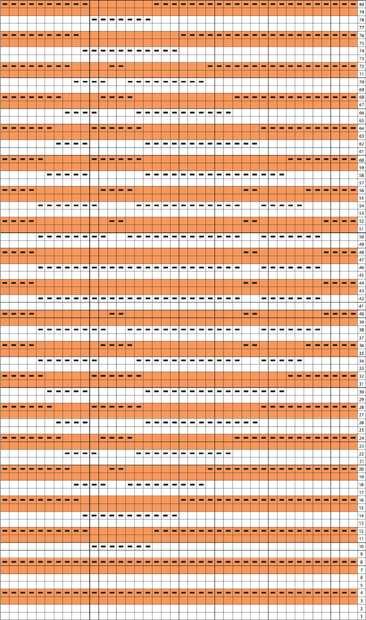
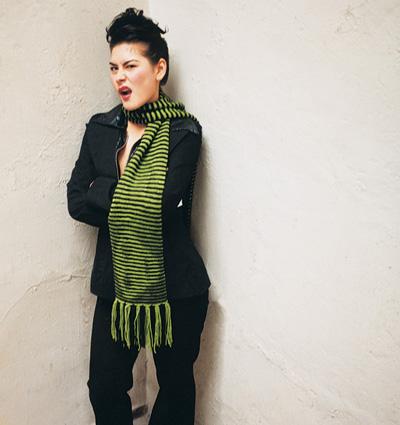
ABOUT SHETHA

I have been knitting steadily for about eleven months. Although I first learned to knit at the age of eight, my short attention span caused my knitting skills to lie dormant for several years. Later, at the age of twenty-one, I decided that knitting was a good way to make use of time while guarding my clothes in the Laundromat (after having had my wash stolen). I read some knitting magazines and realized that I had the skills to create my very own sweater. Since then, I have been sketching my own designs and creating things from others’ designs. My love of knitting has grown stronger through the support of local knitting groups in Portland, Oregon, and online. On my knitting blog,
www.shetha.com/blog
, I share both my knitting successes and failures with knitters around the world.
ALEX ZORN
This hat is a must-have in any knitter’s repertoire because what’s better than kicking out a warm, snuggly hat in just two hours? The pattern is especially useful if you’re an advanced beginner—ready to branch out beyond the rectangle but still a bit intimidated by a circular project. The theme of “fire” came out of my experimentation with crazy red hair. As my hair dye (Manic Panic) gradually washes out, it follows what I affectionately call the “Photoshop flame gradient”—an ever-changing variation of reds, oranges, and yellows. In homage to my crazy hair, I came up with Hot Head—fun, simple stripes in a fiery sequence.
